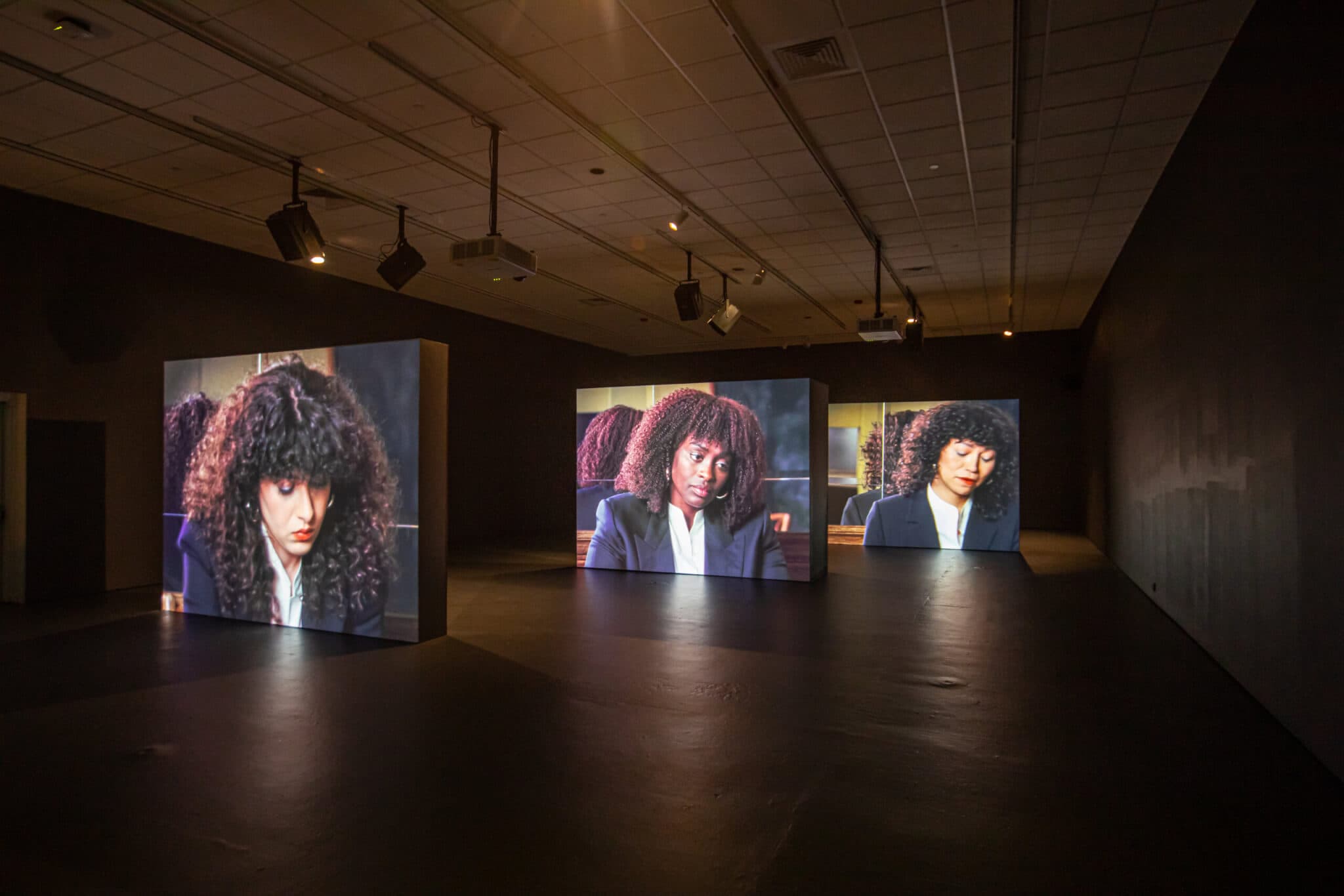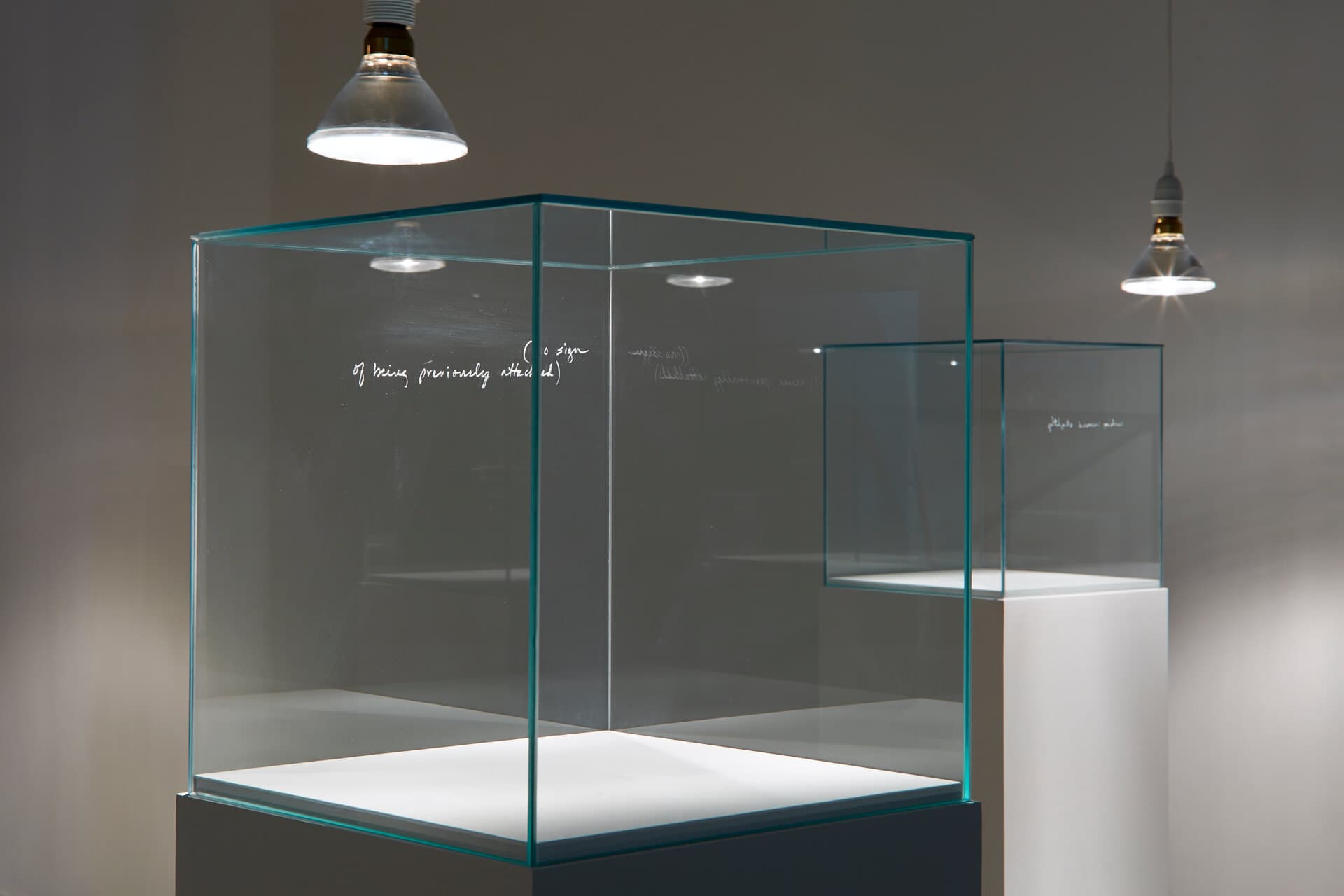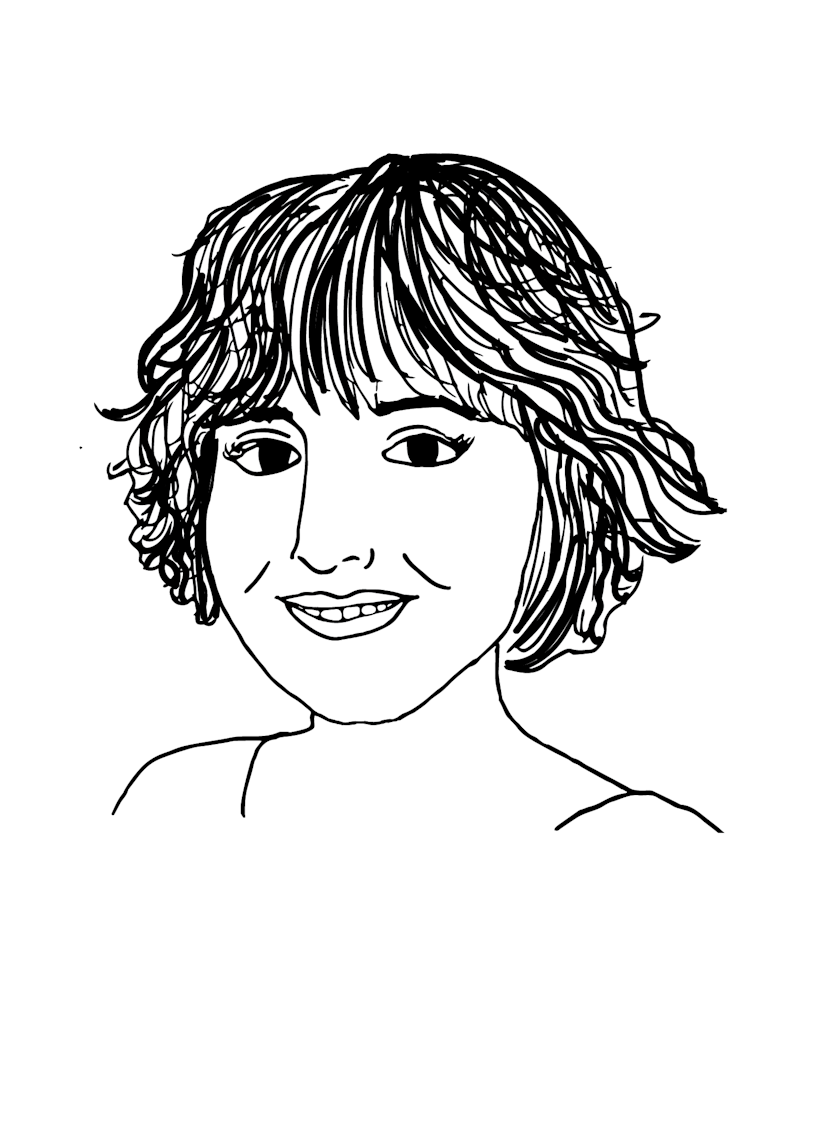Greater Boston born-and-bred and now New York City-based artist and filmmaker Elisabeth Subrin’s work bridges experimental video art, narrative storytelling, sculpture, installation, activism, and more to excavate and chronicle women’s messy, resilient, and exquisitely complex inner workings.
For nearly thirty years, Subrin has examined the way women navigate a world that simultaneously adulates, commodifies, and constrains them, beginning with her early shorts Swallow (1995), a searing condemnation of the toxic diet culture that claimed the life of her sister’s best friend; Shulie (1997), a shot-by-shot recreation of the 1967 biopic that transported trailblazing feminist Shulamith Firestone into the late ’90s; and The Fancy (2000), a dreamy critique of the scholarly diminishment of photographer Francesca Woodman’s brief but prodigious career. She expanded on these themes, continuing her focus on Woodman, with her first sculpture exhibition, “Damage Report,” held at ICA Philadelphia in 2014. In recent years, her work has dealt heavily with the public fascination with and exploitation of actresses, first through her blog Who Cares About Actresses? and then with her first full-length film, A Woman, A Part (2016).
Now, the artist has taken on her most ambitious interdisciplinary work yet with The Listening Takes, a three-channel video installation that builds on her experiences across these media: incorporating sculpture, re-enactments of archival material, an intensely complex soundscape, and the reclamation of a famously ill-treated actress. The piece stages three re-enactments of a 1983 interview with Maria Schneider, who at nineteen was subjected to an unscripted rape scene during the shooting of Bernardo Bertolucci’s controversial 1972 film Last Tango in Paris. Subrin dedicated three screens to three actresses known for their activism—Manal Issa, Aïssa Maïga, and Isabel Sandoval—framing each in a mirrored surround that intermingles the audience within the scene, demanding the viewer confront their engagement with the cavalier violence that the interviewer levels at Schneider throughout her questioning. Recently, I had the opportunity to discuss The Listening Takes, among other things, with Subrin over a happily tangential Zoom call. Our roving conversation covers the artist’s time at MassArt, the power of creative partnerships, and the role of care in creating work that identifies and illuminates personal and collective trauma.

Elisabeth Subrin, “The Listening Takes,” installation view, David Winton Bell Gallery at Brown University, 2023. Video installation, color, sound, 30 minutes. Photo courtesy of David Winton Bell Gallery.
Jessica Shearer: I didn’t realize that you’re from Newton! You went to MassArt. You’ve taught at Harvard; your parents live in Cambridge. Can you tell me more about your time here? Were there any local spaces or people who were particularly important to your development?
Elisabeth Subrin: MassArt was profoundly formative. The culture in the film program at that time was very experimental and a little chaotic and completely incredible. I had teachers like Mark Lapore, Phil Solomon, Saul Levine, Ericka Beckman, and Marjorie Keller, all key avant-garde film figures. It was life-altering to get to study with all of them.
I was also studying video art at the same time. And I feel like my work—at least my experimental work—weaves those mediums together. I took classes with Tony Oursler, who was becoming a major video artist. The departments were separated, but I very quickly started working across them, which I don’t know if my teachers liked. The film courses were lyrical and material and personal, whereas video art offered me more of the immediacy, the performance elements, and also the political elements.
Both programs were hugely rigorous and radical and shaped me way more than graduate school. I can’t say enough good things about MassArt at that time.
JS: You can see the way both of those disciplines play out in your work—particularly in the way that you investigate how our cultural systems can undermine and sabotage women. Your work seems to—and tell me if I’m wrong here—expose a vicious cycle. It investigates the way the world (1) reduces women, (2) feeds them messages about that reduction (which are typically digested in a harmful way), and then (3) picks apart how that trauma manifests, which is then repackaged and given back to them… and on and on. But it’s also very meta, because in a way you’re using the same mediums you’re critiquing (film, storytelling) to expose that harm. Are you conscious of that dichotomy?
ES: Yes, I think you’re totally right about the way I use the media in both ways: using it as an example of a problem, and then trying to carve out within that problem another narrative. What works are you thinking about specifically?
JS: I’m thinking of your short films Swallow (1995) and The Fancy (2000).
ES: Yes, you can really see my obsession with journalism in Swallow. I remember I was thinking it was almost like reporting from a girl’s bedroom. The microphone becomes symbolic, and my narration is a report from that era and location.
With The Fancy, I wanted to expose how much people—in this case specifically scholars—are missing in Francesca Woodman by the way they keep using her; they keep talking about her as a representation of Women with a capital W. But actually she’s a very specific type of woman. She’s very young, beautiful, white, advantaged in every way, considered perfect aesthetically by Western culture, at least in the last century. And she’s also a unique and brilliant and damaged person. They’re using her as a symbol with very little conversation or problematizing about how you can make those generalizations about her. Yeah, I just found it very reductive, and I wanted to expose that.
JS: How do you think it plays out in The Listening Takes?
ES: I think that I expose problems with journalism and the archives even further with The Listening Takes, because we had to so carefully track the five shots of the original interview to recreate every element of the production. I spent a lot of time thinking about the interviewers’ tactics from question to question. They soften her by asking her about her childhood and then just go in for the kill. Seemingly so simple, it’s actually an incredible trajectory, and it feels very intentional, of course, in the edit. And we had to ask ourselves, because it isn’t clear: Did that narrative happen in the cut of the interview or did that happen in the interview? We think it was probably in order, but Maria smoked so much you can’t just watch the cigarette, and it’s hard to tell because there are no clocks, only subtle changes in light.

Elisabeth Subrin, “The Listening Takes,” installation view, David Winton Bell Gallery at Brown University, 2023. Video installation, color, sound, 30 minutes. Photo courtesy of David Winton Bell Gallery.
JS: Let’s back up and just set up the scene here, because the installation of this piece is really remarkable. The format of the three actresses on the three screens with the mirrored backs, the soundscape, it all creates a dynamic where the audience can be very active participants—did you think a great deal about the audience member as a component in this piece?
ES: Yeah, absolutely. I mean, it was impossible not to think about it given that it was such huge amounts of glass. And also, the half wall has a mirrored side that holds you in that space. We thought a lot about what it was going to be like to stand in front and look at oneself with Aïssa or Isabel there. And then, really importantly, what it would be like to go behind Isabel’s wall and have to only see yourself. It can be very uncomfortable to be in a public space looking at yourself and your body.
Also, there are the reflections of the projections. So literally on Manal’s back is Aïssa’s reflection—or you could say on Aïssa’s reflection is Manal’s projection. You can see in the ordering of screens how history is moving from Manal to Isabel in the correct chronological timeline. But then that timeline is confused by also reflecting them on the mirrored backs. I was thinking about fragmentation and distortion as another vantage point. Like, what is the difference between looking at Aïssa projected purely and Aïssa that through a grid? It becomes diagnostic and a little bit trappy.
JS: It encourages the viewer to move around the space, and so the first time I realized that there were deviations in the script, I was moving. It’s disorienting in a good way to be so enmeshed with it when you start to realize that something is a little different. There’s this exciting moment when you realize that something is changing. How did you accomplish those tiny script adjustments—given that the shots and the soundscape are so carefully orchestrated?
ES: I asked them a very specific question, which was: What are the fewest words you could change to make it true to your experience? We did this in rehearsals and then it was scripted. And so when Aïssa or Isabel got on the set, even for the earlier shots, we had already scripted what they said.
JS: And Manal Issa did a truly frame-by-frame recreation, correct? Having watched the original interview, it’s downright eerie how similar she is to Maria.
ES: There have been people in audiences that thought Manal was Maria. She’s both very technical and deeply intuitive and had an incredible emotional connection to the material based on her own experiences in the industry.

Elisabeth Subrin, “The Listening Takes,” installation view, David Winton Bell Gallery at Brown University, 2023. Video installation, color, sound, 30 minutes. Photo courtesy of David Winton Bell Gallery.
JS: The soundscape really reinforces this sense of a connective network. There are so many speakers in this room with so many specific tasks. What was the mixing process like for this piece?
ES: I learned so much with the sound, with communicating the layering of time and experience in ways that advance beyond what you could do in an image track or on a single-channel piece. We literally produced a sound-by-sound recreation of every single sound in that café [from the original interview].
Our mixer insisted that we reproduce the space in Paris in order to do the installation mix. We did it in a large recording studio [rather than a film edit suite] to make sure it was sonically perfect. We had three large flat-screen monitors to simulate the spatial relations of the installation—and we would move through the space physically to adjust the mix. Once we were in that space, we realized that we needed more speakers—not just designated to each actress but also facing the opposite way, so that when you’re looking at Aïssa listening, Manal feels right there at the spatial angle that she would actually be.
And then, because Isabel’s behind Aïssa and Aïssa’s behind Manal, their sound comes from the speakers that are in front of them. And that’s why there’s so many speakers, so that when you walk between Manal and Aïssa and Manal is speaking, you feel Manal right there in front of Aïssa, not far away.
JS: The result is exciting and disorienting, because depending on where you stand and depending on where it is in the piece, if they’re all talking at once or if they’re talking separately or if they’re listening, you feel like you’re with them. And while all of this is happening, you see yourself—your full body—whereas they’re in a fairly tight shot, but you’re smaller than they are. I felt both very welcomed but also very implicated that I was part of the problem.
ES: I think the installation is smarter than me, that I haven’t caught up to all the dimensions of it. I’m still learning what the piece does. I feel like it does what I wanted it to do, but it does more than what I wanted it to do. Especially the ways in which the physical and sonic sculptural elements are articulating ideas I have about history and representation in biography.

Elisabeth Subrin, “Damage Report,” installation view, ICA Philadelphia, 2014. Front left object: No Sign of Being Previously Attached, 2014. Etched glass vitrine. Photo courtesy of the artist.
JS: Kate Kraczon curated this exhibition. You have clearly developed a partnership built on trust; this isn’t the first time you’ve worked together. She also curated your show “Damage Report” (2014) at the Institute of Contemporary Art at the University of Pennsylvania, which also used sculptural glass elements and autobiography in really interesting ways. Can you tell me about that show? Did you learn anything from that exhibition or that partnership that made its way into The Listening Takes?
ES: Kate did a studio visit with me a few years before “Damage Report.” For the ICA’s fiftieth anniversary, they commissioned artists to choose one pivotal show in the museum’s history to respond to, and Kate asked if I would do Francesca Woodman’s 1989 exhibition. I was really torn; I felt like I didn’t have anything more to say [about Woodman]. But when we went to look at the archival material left from that show, I was struck by the way the registrar’s writing documenting damage to the photographs inadvertently echoed Woodman’s internal life, and even some of the titles of her own work. And so what I had engraved on [the glass sculptures] is the literal handwriting of the registrar’s description of the work’s damage. Meanwhile The Fancy is presented down the hallway; it was so amazing to hear the soundtrack reverberating into the space that already felt kind of like a mausoleum. That probably was the beginning of me really thinking about how sound affects space.
JS: And what was it like to work with Kate?
ES: Kate’s amazing. She’s a deeply creative curator and producer. Her own ideas and her guidance mean a lot to me and I trust her and I trust her understanding my work.
She is so good at producing artists’ visions. The Listening Takes was an insanely more ambitious project. The level of faith she put into it: The Bell Gallery was one of the first significant funders of the film, which took a year and a half to fundraise for. For Kate to have so much trust that it would be finished in time was amazing. And as I got more specific about the walls and more ambitious about the mirrors—it’s like a ton of glass that got hand desilvered in Brooklyn—she remained determined to achieve our original vision.
I was like, okay, we can pull it back because it was a lot to execute, to transport, to pay for. We would come up with plan Bs, but once we got to those points, Kate would say, “No, I’m just going to figure this out so we can do this.” She’s an enabler of ambition.
JS: Your work in many cases seems to stem from these creative kinships—with Woodman, with Schneider, with so many—and I wonder, do you feel as if they are aspects of yourself? Or do you feel like you’ve moved beyond that and it’s aspects of womanhood? Or is there no difference?
ES: I remember showing Shulie (1998) at the ICA in Boston and Saul Levine saying, “This is autobiography,” and I never thought about that. But when I look back, I do think I can really relate to some of the things she said and went through. In Swallow, I was really playing around with the line between biography and autobiography; I blur it.
Sometimes I feel like I stumble into characters like Woodman or Maria or Shulamith Firestone and they become these incredible avatars for my ideas. I’ll probably know in a few years if she feels personal to me; now I don’t think of her that way. I’ve been researching her for a few years with the intention of making a hybrid feature-length biopic.
JS: There’s something I want to make sure we get to, because I think it’s very unique to you—which is this sense of care that you offer both the subject and the audience, even though the work remains very conceptual and intellectual. Watching you feels to me like you’re offering us a corrective, like you’re opening a door and saying: You could take this route.
ES: One hundred percent everything you said.
JS: The way that plays out in The Listening Takes, I won’t give away specifics here, but the way that Isabel Sandoval’s piece ends, it’s like a gift. Almost, if she were here, this is what you would want her to have had the autonomy to do.
ES: I think you’re talking about compassion, and I did think a lot about: What would Maria be saying right now? And I don’t think she would like anything that was made really that exposed her. But I do wonder if she had the courage to say in 2007, “I felt a little raped,” where would she be in 2023?
“Elisabeth Subrin: The Listening Takes” is on view through June 4, 2023 at the David Winton Bell Gallery at Brown University.





